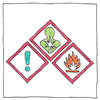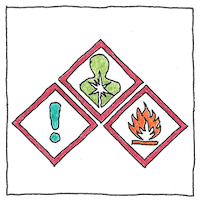Michael Faraday
chemistry

|
Benzene
The Portable Gas Company found that compressing a thousand cubic feet of illuminating gas into bottles produced a gallon of mysterious liquid that could be drawn off by opening valves on the bottom of the bottles. Michael Faraday separated this liquid into parts using repeated fractional distillation and condensation, which eventually produced “bi-carburet of hydrogen” that crystalized on cooling into brittle branchlike structures evaporated when exposed to air, and burned with a white flame. By additional tests and measurements, Michael Faraday determined its composition by weight to be 1 part hydrogen to 12 parts carbon. Modern atomic weights give a ratio of 1 to 11.92.
Benzene names
This chemical has many names, even restricting our list to English and the language of chemistry. Benzene has been known as C6H6 Cyclohexatriene Cyclohexa-1,3,5-triene 1,3,5-Cyclohexatriene and [6]Annulene Benzol Benzole Benzolene Motor benzol Benzol 90 BNZ and RNG Benzolum Benzinum Benzine Benzin Benzeen and Benzolo Bi-carburet of hydrogen Phenyl hydride Carbon oil Coal naphtha and Mineral naphtha Phene Pyrobenzol Pyrobenzole Fenzen and Polystream.
Benzene lamp
Michael Faraday wanted to produce a lamp containing a liquid under low pressure and a combustible vapor at less pressure to produce a constant light for a length of time and he did, although it was only a “curiosity” because processes for easily producing benzene in sufficient quantities had not been invented.
Cooking with gas
Now we’re cooking, all jazzed up, hot to trot, bursting with joy, and ready to blast off. We’re mixing it up. No moss will grow where we burn rubber.



Benzene is harmful, nauseating, and flammable.
At the time, most illuminating gas was produced by destructive distillation of coal or peat; however, the Portable Gas Company made their gas from oil. Michael Faraday’s brother Robert worked for the Portable Gas Company.
See also in The book of science:
Readings in wikipedia:
Other readings: